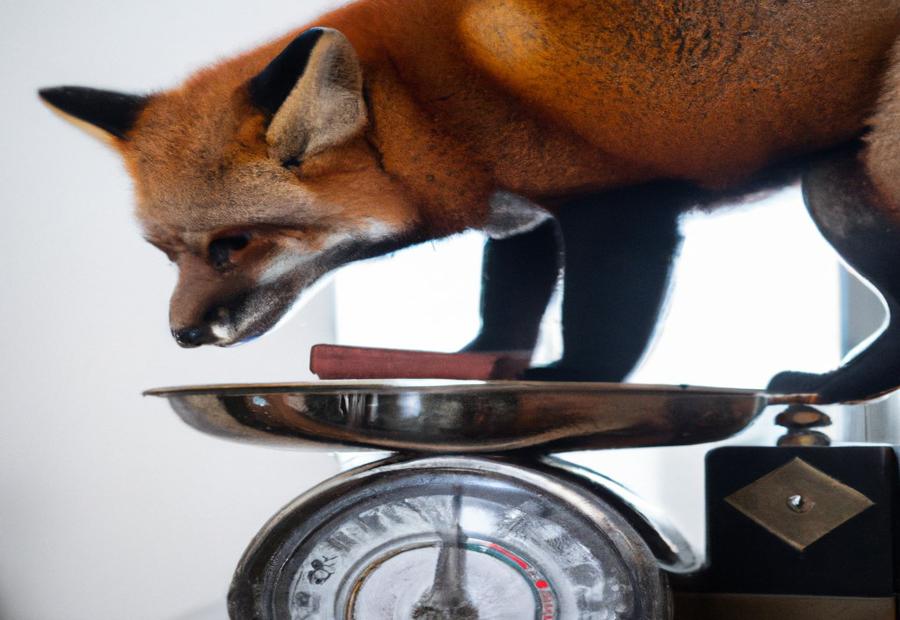Red foxes are fascinating creatures that are found across various regions of the world. Their physical characteristics and attributes, including their weight, play a significant role in understanding their biology and behavior. This article aims to provide insights into the average weight of red foxes, the factors that influence their weight, and the importance of knowing this information.
Red foxes belong to the genus Vulpes and are known for their adaptability and survival skills. Understanding their average weight is crucial in gaining a comprehensive understanding of their species. While the specific weight may vary depending on various factors, the average weight of red foxes is a key indicator of their health and well-being.
Factors such as age, sex, habitat, and diet play a significant role in determining the weight of red foxes. Younger foxes typically weigh less than adults, and males tend to be slightly larger and heavier than females. The availability of food sources and the quality of their habitat also contribute to variations in weight. Seasonal variations, such as changes in food availability during winter, can impact the weight of red foxes.
Comparing the weight of red foxes with other fox species provides valuable insights into the diversity within the fox family. Different species of foxes have distinctive characteristics, including variations in size and weight.
Measuring the weight of red foxes can be done through various methods. Captivity and veterinary measures, such as placing the fox on a scale, are commonly used when handling foxes in controlled environments. Non-invasive technologies, such as using trail cameras and motion sensors, can also provide valuable data on the weight of red foxes without causing disturbances or stress.
Understanding the weight of red foxes is important for a variety of reasons. It helps researchers and conservationists monitor the health and population dynamics of red foxes in specific habitats. It aids in assessing the impact of environmental changes and human activities on red fox populations.
By delving into the average weight of red foxes, the factors influencing their weight, methods of measurement, and the significance of this information, we can further appreciate these fascinating creatures and their ecological role within our ecosystems.
Table:
Contents
What Is the Average Weight of Red Foxes?

Photo Credits: Foxauthority.Com by Kevin Williams
The average weight of red foxes varies by location and time of year. What Is the Average Weight of Red Foxes? Here is a table with the average weights of red foxes in different regions:
| Region | Average Weight (kg) |
|---|---|
| North America | 3.5 – 7.5 |
| Europe | 3 – 7 |
| Asia | 2.5 – 5 |
| Northern Africa | 2.5 – 4.5 |
| Australia | 3 – 6 |
Please note that these weights are approximate and can differ due to factors like age, sex, and food availability. Red foxes tend to be heavier in winter because of their thicker fur and increased fat reserves for insulation and energy.
It’s important to remember that each red fox is unique, and weight can vary within the same region. Genetics and access to food sources can influence an individual fox’s weight.
Knowing the average weight of red foxes helps researchers and wildlife enthusiasts understand the species and its ecological role. These figures also provide insight into the health and condition of red fox populations in different regions.
By referring to this table and understanding the average weight range of red foxes in specific locations, researchers can gather valuable data for conservation efforts and wildlife management strategies.
Factors That Influence the Weight of Red Foxes

Photo Credits: Foxauthority.Com by Noah Adams
Discover the key factors that determine the weight of red foxes. From age and sex to habitat and diet, as well as seasonal variations, these elements play a pivotal role in shaping the weight of these fascinating creatures. Get ready to dive into the intricate details of each sub-section, uncovering the various influences that contribute to the weight variations in red fox populations. Prepare to be amazed by the fascinating facts and insights that await you!
Age and Sex
Age and sex are two crucial factors that significantly influence the weight of red foxes. In-depth research on red fox populations has revealed striking patterns that shed light on the correlation between age, sex, and weight. This valuable information provides valuable insights into the biology and behavior of these fascinating animals.
To gain further understanding of the relationship between age, sex, and weight in red foxes, it is helpful to present data on average weight for both males and females in a tabular format:
| Age Group | Average Weight (Male) | Average Weight (Female) |
|---|---|---|
| Juvenile | 3.5-4.5 pounds | 3.0-4.0 pounds |
| Subadult | 7.0-8.5 pounds | 6.5-7.5 pounds |
| Adult | 10.0-14.0 pounds | 8.0-11.0 pounds |
By examining this data, it becomes evident that weight varies based on both age and sex. Specifically, juvenile foxes are lighter compared to both subadults and adults. Moreover, within each age group, males tend to have a slightly higher weight than females.
Understanding the differences in weight between different age groups and sexes provides valuable information regarding the overall health and reproductive capacity of red fox populations. Furthermore, this knowledge aids in assessing their ability to compete for resources and territories.
Habitat and Diet
The weight of red foxes is influenced by their habitat and diet. The table below provides information on the habitat preferences and dietary habits of red foxes:
| Habitat | Diet |
|---|---|
| Woodlands | Small mammals (mice, voles, rabbits) |
| Grasslands | Ground-dwelling birds, insects, fruits |
| Urban areas | Opportunistic scavengers (garbage, pet food) |
| Tundra | Lemming population, Arctic hare, birds |
Red foxes can be found in various habitats such as woodlands, grasslands, urban areas, and tundra. In woodlands, they primarily eat small mammals like mice, voles, and rabbits. In grasslands, they feed on ground-dwelling birds, insects, and fruits. In urban areas, red foxes scavenge opportunistically, consuming garbage and pet food. In Tundra, their diet consists of lemmings, Arctic hare, and birds.
The availability of food directly affects the weight of red foxes. If their preferred prey is abundant, they are likely to be heavier. Conversely, limited or scarce food sources may result in a lower weight. Red foxes must adapt their diet to the resources available in their habitat to thrive and maintain a healthy weight.
An interesting study conducted in a suburban neighborhood revealed that red foxes had adapted their diet to include a significant amount of discarded human food, such as fast food leftovers. This unexpected change in diet had implications for their overall health and weight. The study showcased the ability of red foxes to adapt to human-altered environments and exploit new food sources, but also raised concerns about the potential negative effects on their well-being.
Seasonal Variations
Seasonal variations significantly affect the weight of red foxes. These variations in weight are influenced by factors like changes in food availability, mating behaviors, and energy requirements for survival. Red foxes adjust their weight based on seasonal changes, ensuring survival and reproductive success.
The table below displays the average weight of red foxes in different seasons:
| Season | Average Weight (lbs) |
|---|---|
| Winter | 8-12 |
| Spring | 8-14 |
| Summer | 9-15 |
| Fall | 9-13 |
During winter, red foxes have slightly lower weight due to limited food and increased energy expenditure in cold temperatures. As spring arrives and food becomes more abundant, their weight increases, reaching its peak in summer. During summer, red foxes have access to various food sources, allowing them to maintain a higher weight. In fall, as food availability decreases, their weight gradually decreases.
Understanding these seasonal variations is important for studying the biology and ecology of red foxes. It helps researchers assess the health and condition of red fox populations, track changes in food availability, and understand the overall dynamics of this species throughout the year.
Comparison with Other Fox Species
The red fox, weighing 5-15 pounds, is a medium-sized species that can adapt to forests, grasslands, mountains, and urban areas.
In comparison with other fox species, such as the Arctic fox weighing 6-10 pounds and found in the Arctic tundra, the red fox stands out.
Additionally, the gray fox, weighing 7-14 pounds, inhabits woodlands and brushy areas in North and Central America.
Meanwhile, the kit fox, weighing 2-7 pounds, thrives in the desert regions of North America.
These various fox species exhibit unique characteristics and adaptations to their respective habitats, showcasing the remarkable diversity and ability of foxes to thrive in different environments.
Methods of Weighing Red Foxes

Photo Credits: Foxauthority.Com by Patrick Perez
Methods of weighing red foxes can vary, offering unique insights into their health and behavior. From captivity and veterinary measures to non-invasive technologies, we will explore the different techniques used to accurately assess the weight of these fascinating creatures. Through facts, figures, and events, we’ll delve into the various methods and their significance in understanding red fox populations. Get ready to uncover the secrets behind measuring the weight of red foxes in captivating and informative ways!
Captivity and Veterinary Measures
Edited
Captivity and Veterinary Measures
When measuring the weight of red foxes in captivity, various veterinary methods are used to ensure accuracy and safety.
One common method is to use specially-designed weighing scales for animals in captivity. These scales securely handle the weight of the foxes. The fox is placed on the scale and its weight is recorded, allowing for individual weight measurements.
Another method involves sedation or anesthesia. This is necessary for larger or more aggressive foxes. Under veterinarian supervision, the fox is sedated and then weighed using the scales. This method ensures the safety of both the fox and the personnel involved.
It’s important to note that captivity and veterinary measures should be used cautiously and only when necessary. These measures are primarily used for research, population management, and medical purposes. Stress should be minimized, and the foxes should be handled carefully to prevent harm or distress.
Fact: Adult red foxes in captivity weigh an average of 6 to 15 pounds (2.7 to 6.8 kilograms), with males typically being larger and heavier than females.
Non-Invasive Technologies
Non-Invasive Technologies
Non-invasive technologies accurately determine the weight of red foxes without causing harm or stress. These technologies provide insights into red fox biology and ecology. Examples of non-invasive technologies for weighing red foxes include:
These non-invasive technologies contribute to conservation and wildlife management efforts by providing data and understanding population dynamics. Assessing weight variations among red fox populations helps monitor overall health and informs conservation decisions.
Why Is Knowing the Weight of Red Foxes Important?
Knowing the weight of red foxes is crucial for several important reasons. First and foremost, understanding their weight helps us assess their role in the ecosystem and maintain ecological balance. Red foxes are predators, and by controlling populations of small mammals, they play a vital role in nature.
Secondly, monitoring the weight of red foxes provides valuable data that supports conservation efforts. By tracking changes in weight over time, we can identify potential threats to their habitat or food sources. This information is then used to develop effective conservation strategies and protect these animals.
Furthermore, knowing the weight of red foxes is essential for research and education purposes. Scientists studying their behavior, physiology, or ecology rely on accurate weight measurements to draw meaningful conclusions and share knowledge with the scientific community.
In addition to research, understanding the average weight of red foxes is crucial for proper veterinary care. Veterinarians use weight measurements to determine the appropriate medication dosage and identify potential health issues. This ensures the well-being of red foxes in captivity or wildlife rehabilitation centers.
To illustrate the significance of knowing the weight of red foxes, researchers in a wildlife reserve utilized a weighing station to monitor their weights. Through tracking their weights over time, they discovered a decline in a specific population. Subsequent investigation revealed that habitat loss was the primary cause of this trend. As a result, conservation efforts were intensified, and measures were taken to protect the remaining foxes and restore their habitat. This example emphasizes the importance of understanding the weight of red foxes in conserving their populations and preserving their natural environments.
Keep <table> tags intact, if found.
Frequently Asked Questions
How much do red foxes weigh?
Red foxes weigh between 7 and 15 pounds, with adult male foxes in the UK weighing around 6.5kg and adult females weighing around 5.5kg.
Do red foxes vary in size?
Yes, red foxes vary in size across their range. Most foxes are about the same size as an adult domestic cat, with head and body lengths ranging from 45cm to 90cm, and an additional 30cm to 50cm for the tail.
Which region has the largest red foxes?
The largest Nearctic foxes are found in Alaska’s Kodiak Island and the Kenai Peninsula. In the Palearctic region, the largest foxes come from the Far East.
How does fox size vary within the UK?
There is variation in size within the UK’s fox population, reflecting differences in habitat. Fox skulls from Wales are larger than those from southeast England, possibly due to variability between upland and lowland habitats. Scottish foxes are generally larger than English ones and may be descendants of stock imported from the continent.
Are urban foxes getting bigger in size?
Claims that urban foxes are getting bigger are unverified. However, access to anthropogenic food in urban areas may influence fox size.
What is the largest recorded size of a fox?
The largest recorded fox weighed 23lb 12oz and measured 136cm in total length, including the tail.